Cross-Cultural Management: Australia vs South Africa Culture Analysis
VerifiedAdded on 2021/06/18
|15
|4194
|253
Report
AI Summary
This report provides a comparative analysis of the cultures of Australia and South Africa, focusing on similarities and differences in various aspects. The introduction defines culture, cultural intelligence, and cross-cultural management. The similarities highlighted include multiculturalism, English language usage, shared experiences of slavery, Christianity as a dominant religion, legal same-sex marriage, and monogamous marriage customs. Both countries also share artistic backgrounds. The report then contrasts the two cultures by examining differences in religion (with South Africa having a stronger indigenous religious presence), racial conflict (more pronounced in South Africa), and population demographics (different white/black population ratios). The analysis includes historical context and societal implications, offering a comprehensive overview of the cultural landscapes of both nations.
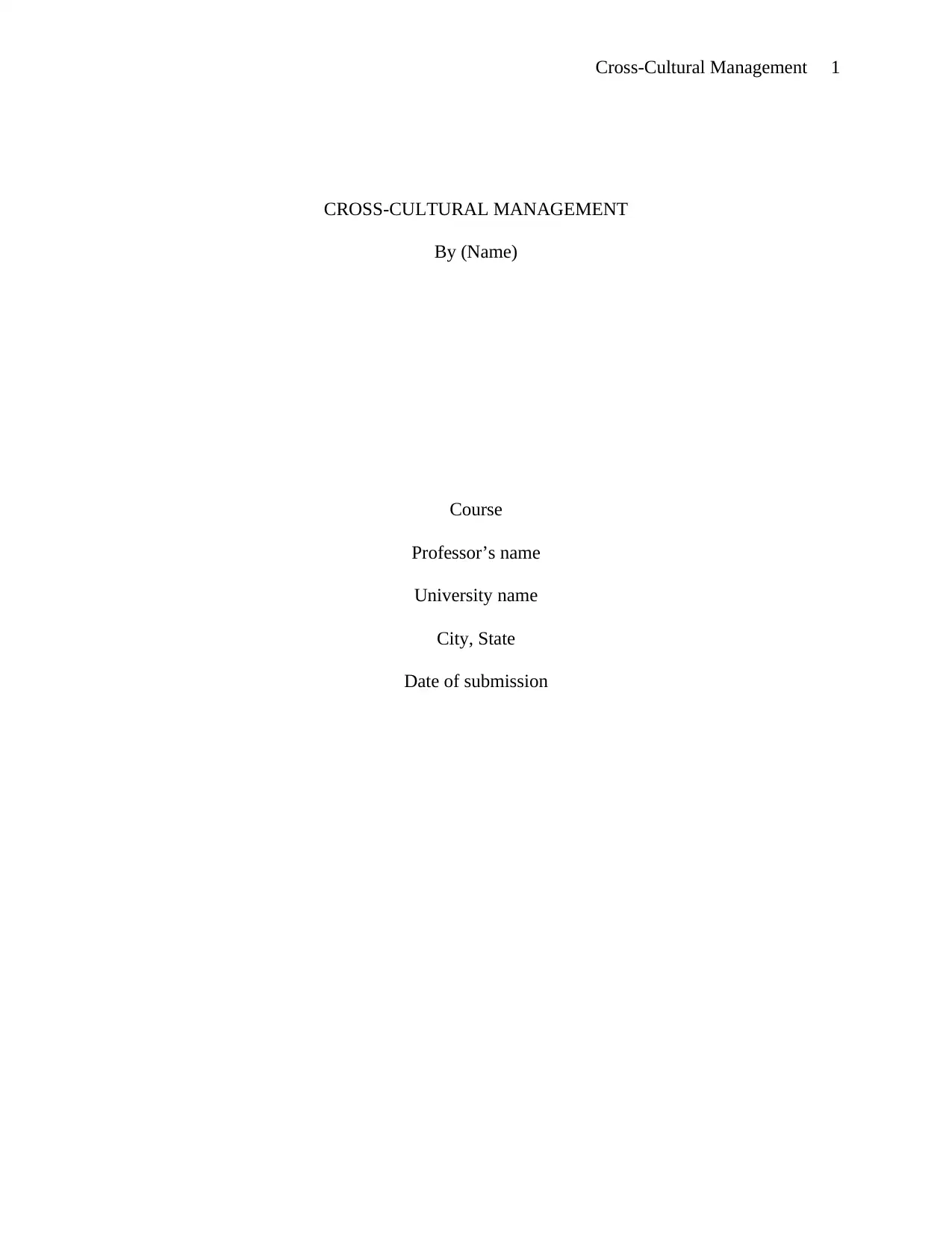
Cross-Cultural Management 1
CROSS-CULTURAL MANAGEMENT
By (Name)
Course
Professor’s name
University name
City, State
Date of submission
CROSS-CULTURAL MANAGEMENT
By (Name)
Course
Professor’s name
University name
City, State
Date of submission
Paraphrase This Document
Need a fresh take? Get an instant paraphrase of this document with our AI Paraphraser
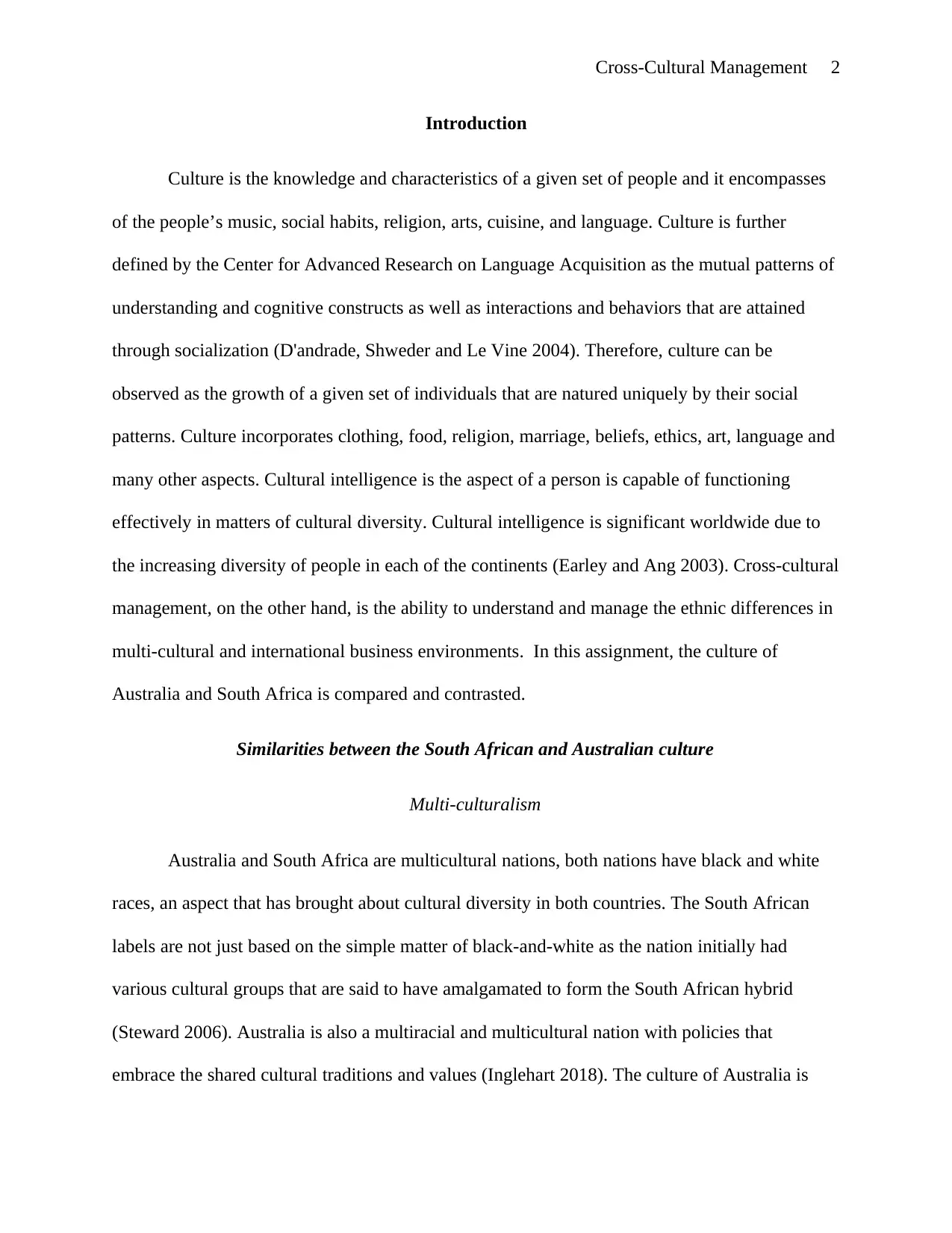
Cross-Cultural Management 2
Introduction
Culture is the knowledge and characteristics of a given set of people and it encompasses
of the people’s music, social habits, religion, arts, cuisine, and language. Culture is further
defined by the Center for Advanced Research on Language Acquisition as the mutual patterns of
understanding and cognitive constructs as well as interactions and behaviors that are attained
through socialization (D'andrade, Shweder and Le Vine 2004). Therefore, culture can be
observed as the growth of a given set of individuals that are natured uniquely by their social
patterns. Culture incorporates clothing, food, religion, marriage, beliefs, ethics, art, language and
many other aspects. Cultural intelligence is the aspect of a person is capable of functioning
effectively in matters of cultural diversity. Cultural intelligence is significant worldwide due to
the increasing diversity of people in each of the continents (Earley and Ang 2003). Cross-cultural
management, on the other hand, is the ability to understand and manage the ethnic differences in
multi-cultural and international business environments. In this assignment, the culture of
Australia and South Africa is compared and contrasted.
Similarities between the South African and Australian culture
Multi-culturalism
Australia and South Africa are multicultural nations, both nations have black and white
races, an aspect that has brought about cultural diversity in both countries. The South African
labels are not just based on the simple matter of black-and-white as the nation initially had
various cultural groups that are said to have amalgamated to form the South African hybrid
(Steward 2006). Australia is also a multiracial and multicultural nation with policies that
embrace the shared cultural traditions and values (Inglehart 2018). The culture of Australia is
Introduction
Culture is the knowledge and characteristics of a given set of people and it encompasses
of the people’s music, social habits, religion, arts, cuisine, and language. Culture is further
defined by the Center for Advanced Research on Language Acquisition as the mutual patterns of
understanding and cognitive constructs as well as interactions and behaviors that are attained
through socialization (D'andrade, Shweder and Le Vine 2004). Therefore, culture can be
observed as the growth of a given set of individuals that are natured uniquely by their social
patterns. Culture incorporates clothing, food, religion, marriage, beliefs, ethics, art, language and
many other aspects. Cultural intelligence is the aspect of a person is capable of functioning
effectively in matters of cultural diversity. Cultural intelligence is significant worldwide due to
the increasing diversity of people in each of the continents (Earley and Ang 2003). Cross-cultural
management, on the other hand, is the ability to understand and manage the ethnic differences in
multi-cultural and international business environments. In this assignment, the culture of
Australia and South Africa is compared and contrasted.
Similarities between the South African and Australian culture
Multi-culturalism
Australia and South Africa are multicultural nations, both nations have black and white
races, an aspect that has brought about cultural diversity in both countries. The South African
labels are not just based on the simple matter of black-and-white as the nation initially had
various cultural groups that are said to have amalgamated to form the South African hybrid
(Steward 2006). Australia is also a multiracial and multicultural nation with policies that
embrace the shared cultural traditions and values (Inglehart 2018). The culture of Australia is
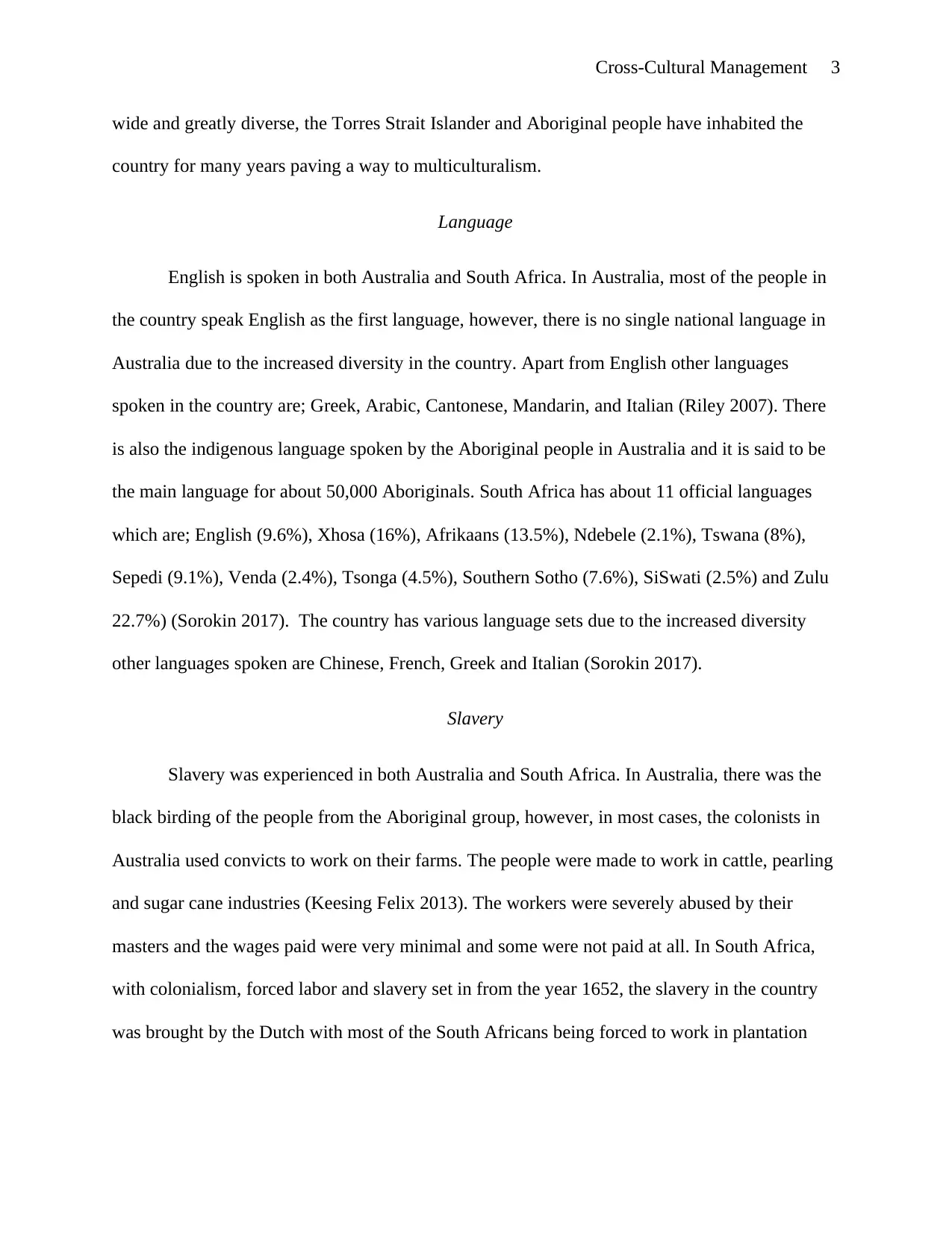
Cross-Cultural Management 3
wide and greatly diverse, the Torres Strait Islander and Aboriginal people have inhabited the
country for many years paving a way to multiculturalism.
Language
English is spoken in both Australia and South Africa. In Australia, most of the people in
the country speak English as the first language, however, there is no single national language in
Australia due to the increased diversity in the country. Apart from English other languages
spoken in the country are; Greek, Arabic, Cantonese, Mandarin, and Italian (Riley 2007). There
is also the indigenous language spoken by the Aboriginal people in Australia and it is said to be
the main language for about 50,000 Aboriginals. South Africa has about 11 official languages
which are; English (9.6%), Xhosa (16%), Afrikaans (13.5%), Ndebele (2.1%), Tswana (8%),
Sepedi (9.1%), Venda (2.4%), Tsonga (4.5%), Southern Sotho (7.6%), SiSwati (2.5%) and Zulu
22.7%) (Sorokin 2017). The country has various language sets due to the increased diversity
other languages spoken are Chinese, French, Greek and Italian (Sorokin 2017).
Slavery
Slavery was experienced in both Australia and South Africa. In Australia, there was the
black birding of the people from the Aboriginal group, however, in most cases, the colonists in
Australia used convicts to work on their farms. The people were made to work in cattle, pearling
and sugar cane industries (Keesing Felix 2013). The workers were severely abused by their
masters and the wages paid were very minimal and some were not paid at all. In South Africa,
with colonialism, forced labor and slavery set in from the year 1652, the slavery in the country
was brought by the Dutch with most of the South Africans being forced to work in plantation
wide and greatly diverse, the Torres Strait Islander and Aboriginal people have inhabited the
country for many years paving a way to multiculturalism.
Language
English is spoken in both Australia and South Africa. In Australia, most of the people in
the country speak English as the first language, however, there is no single national language in
Australia due to the increased diversity in the country. Apart from English other languages
spoken in the country are; Greek, Arabic, Cantonese, Mandarin, and Italian (Riley 2007). There
is also the indigenous language spoken by the Aboriginal people in Australia and it is said to be
the main language for about 50,000 Aboriginals. South Africa has about 11 official languages
which are; English (9.6%), Xhosa (16%), Afrikaans (13.5%), Ndebele (2.1%), Tswana (8%),
Sepedi (9.1%), Venda (2.4%), Tsonga (4.5%), Southern Sotho (7.6%), SiSwati (2.5%) and Zulu
22.7%) (Sorokin 2017). The country has various language sets due to the increased diversity
other languages spoken are Chinese, French, Greek and Italian (Sorokin 2017).
Slavery
Slavery was experienced in both Australia and South Africa. In Australia, there was the
black birding of the people from the Aboriginal group, however, in most cases, the colonists in
Australia used convicts to work on their farms. The people were made to work in cattle, pearling
and sugar cane industries (Keesing Felix 2013). The workers were severely abused by their
masters and the wages paid were very minimal and some were not paid at all. In South Africa,
with colonialism, forced labor and slavery set in from the year 1652, the slavery in the country
was brought by the Dutch with most of the South Africans being forced to work in plantation
⊘ This is a preview!⊘
Do you want full access?
Subscribe today to unlock all pages.

Trusted by 1+ million students worldwide
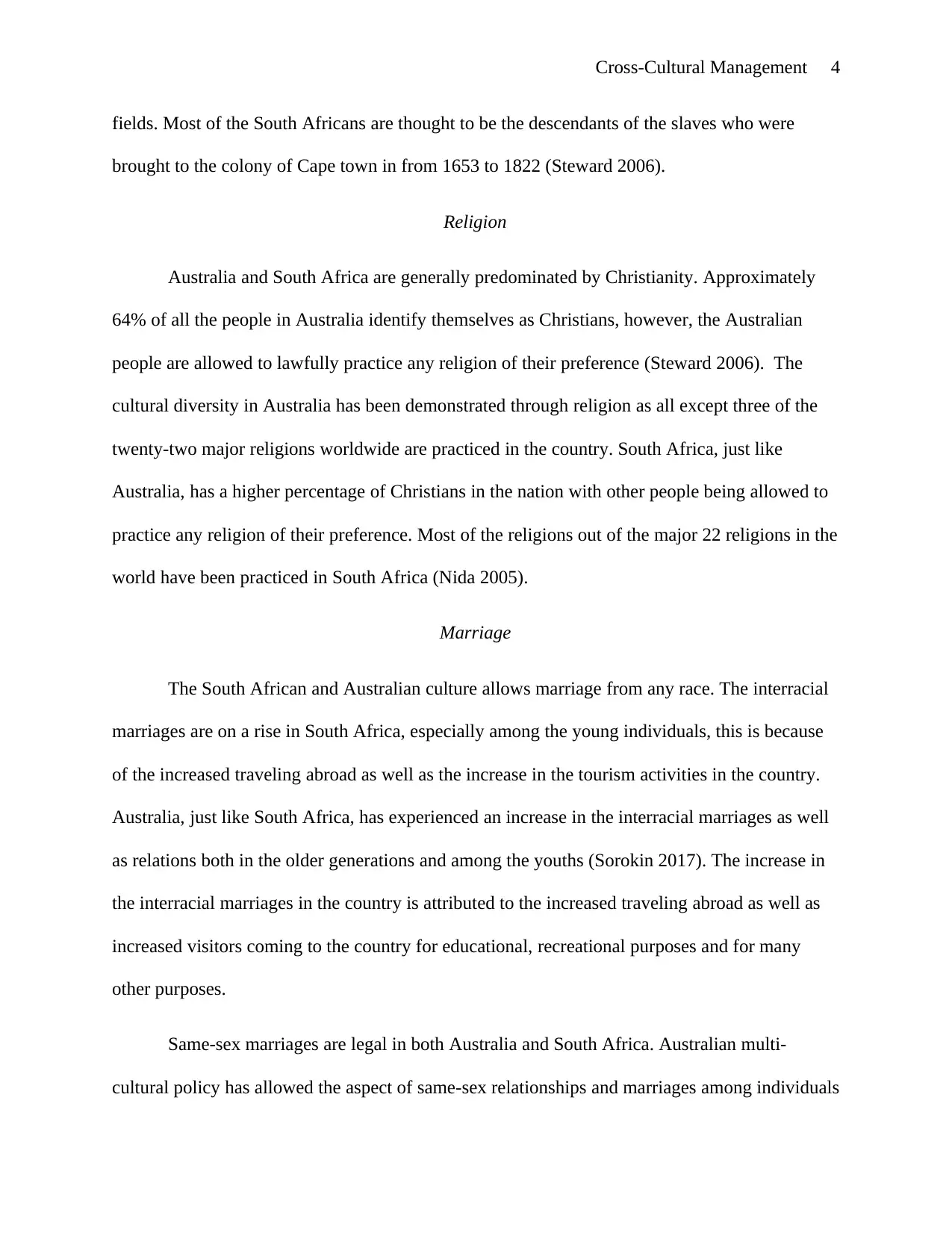
Cross-Cultural Management 4
fields. Most of the South Africans are thought to be the descendants of the slaves who were
brought to the colony of Cape town in from 1653 to 1822 (Steward 2006).
Religion
Australia and South Africa are generally predominated by Christianity. Approximately
64% of all the people in Australia identify themselves as Christians, however, the Australian
people are allowed to lawfully practice any religion of their preference (Steward 2006). The
cultural diversity in Australia has been demonstrated through religion as all except three of the
twenty-two major religions worldwide are practiced in the country. South Africa, just like
Australia, has a higher percentage of Christians in the nation with other people being allowed to
practice any religion of their preference. Most of the religions out of the major 22 religions in the
world have been practiced in South Africa (Nida 2005).
Marriage
The South African and Australian culture allows marriage from any race. The interracial
marriages are on a rise in South Africa, especially among the young individuals, this is because
of the increased traveling abroad as well as the increase in the tourism activities in the country.
Australia, just like South Africa, has experienced an increase in the interracial marriages as well
as relations both in the older generations and among the youths (Sorokin 2017). The increase in
the interracial marriages in the country is attributed to the increased traveling abroad as well as
increased visitors coming to the country for educational, recreational purposes and for many
other purposes.
Same-sex marriages are legal in both Australia and South Africa. Australian multi-
cultural policy has allowed the aspect of same-sex relationships and marriages among individuals
fields. Most of the South Africans are thought to be the descendants of the slaves who were
brought to the colony of Cape town in from 1653 to 1822 (Steward 2006).
Religion
Australia and South Africa are generally predominated by Christianity. Approximately
64% of all the people in Australia identify themselves as Christians, however, the Australian
people are allowed to lawfully practice any religion of their preference (Steward 2006). The
cultural diversity in Australia has been demonstrated through religion as all except three of the
twenty-two major religions worldwide are practiced in the country. South Africa, just like
Australia, has a higher percentage of Christians in the nation with other people being allowed to
practice any religion of their preference. Most of the religions out of the major 22 religions in the
world have been practiced in South Africa (Nida 2005).
Marriage
The South African and Australian culture allows marriage from any race. The interracial
marriages are on a rise in South Africa, especially among the young individuals, this is because
of the increased traveling abroad as well as the increase in the tourism activities in the country.
Australia, just like South Africa, has experienced an increase in the interracial marriages as well
as relations both in the older generations and among the youths (Sorokin 2017). The increase in
the interracial marriages in the country is attributed to the increased traveling abroad as well as
increased visitors coming to the country for educational, recreational purposes and for many
other purposes.
Same-sex marriages are legal in both Australia and South Africa. Australian multi-
cultural policy has allowed the aspect of same-sex relationships and marriages among individuals
Paraphrase This Document
Need a fresh take? Get an instant paraphrase of this document with our AI Paraphraser
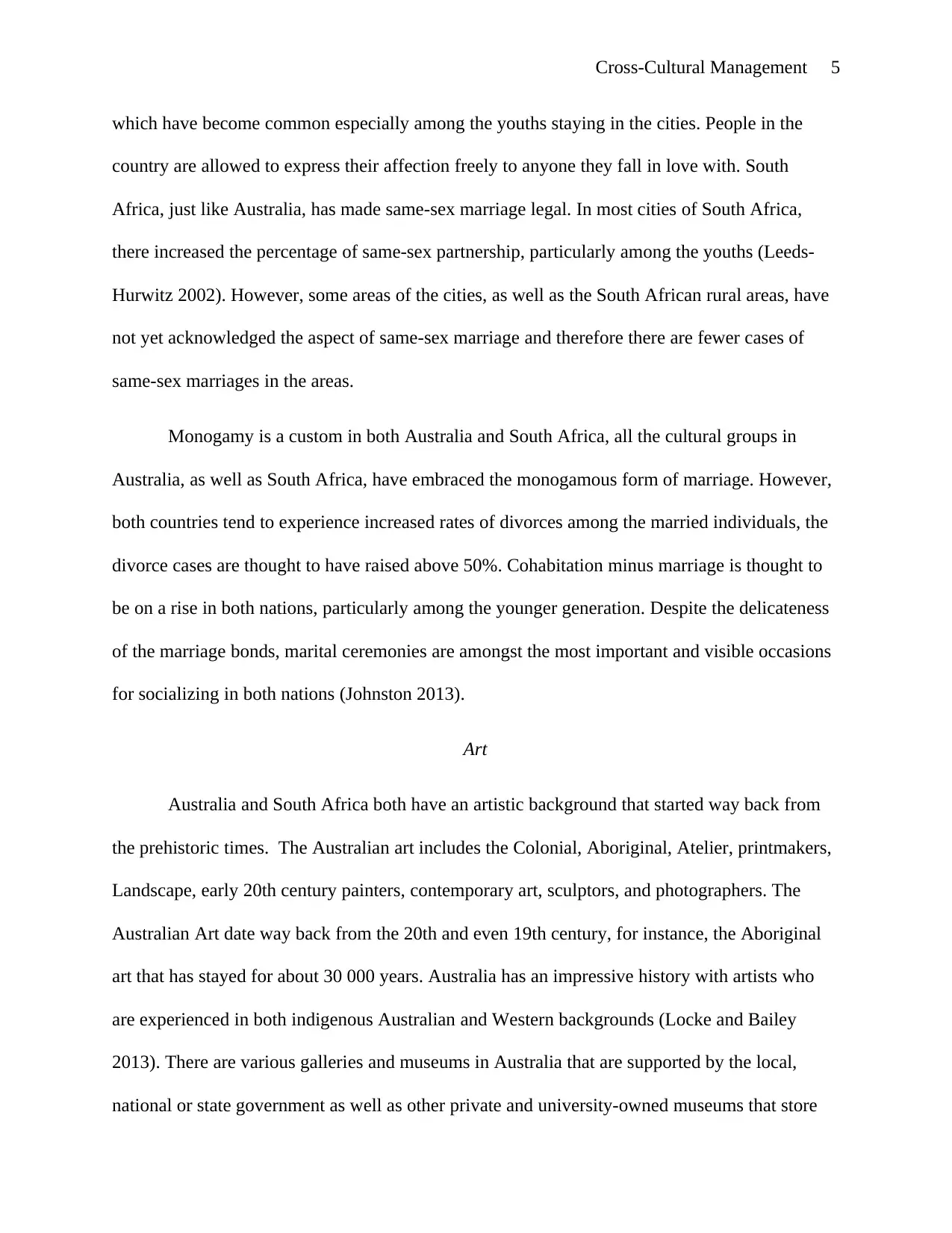
Cross-Cultural Management 5
which have become common especially among the youths staying in the cities. People in the
country are allowed to express their affection freely to anyone they fall in love with. South
Africa, just like Australia, has made same-sex marriage legal. In most cities of South Africa,
there increased the percentage of same-sex partnership, particularly among the youths (Leeds-
Hurwitz 2002). However, some areas of the cities, as well as the South African rural areas, have
not yet acknowledged the aspect of same-sex marriage and therefore there are fewer cases of
same-sex marriages in the areas.
Monogamy is a custom in both Australia and South Africa, all the cultural groups in
Australia, as well as South Africa, have embraced the monogamous form of marriage. However,
both countries tend to experience increased rates of divorces among the married individuals, the
divorce cases are thought to have raised above 50%. Cohabitation minus marriage is thought to
be on a rise in both nations, particularly among the younger generation. Despite the delicateness
of the marriage bonds, marital ceremonies are amongst the most important and visible occasions
for socializing in both nations (Johnston 2013).
Art
Australia and South Africa both have an artistic background that started way back from
the prehistoric times. The Australian art includes the Colonial, Aboriginal, Atelier, printmakers,
Landscape, early 20th century painters, contemporary art, sculptors, and photographers. The
Australian Art date way back from the 20th and even 19th century, for instance, the Aboriginal
art that has stayed for about 30 000 years. Australia has an impressive history with artists who
are experienced in both indigenous Australian and Western backgrounds (Locke and Bailey
2013). There are various galleries and museums in Australia that are supported by the local,
national or state government as well as other private and university-owned museums that store
which have become common especially among the youths staying in the cities. People in the
country are allowed to express their affection freely to anyone they fall in love with. South
Africa, just like Australia, has made same-sex marriage legal. In most cities of South Africa,
there increased the percentage of same-sex partnership, particularly among the youths (Leeds-
Hurwitz 2002). However, some areas of the cities, as well as the South African rural areas, have
not yet acknowledged the aspect of same-sex marriage and therefore there are fewer cases of
same-sex marriages in the areas.
Monogamy is a custom in both Australia and South Africa, all the cultural groups in
Australia, as well as South Africa, have embraced the monogamous form of marriage. However,
both countries tend to experience increased rates of divorces among the married individuals, the
divorce cases are thought to have raised above 50%. Cohabitation minus marriage is thought to
be on a rise in both nations, particularly among the younger generation. Despite the delicateness
of the marriage bonds, marital ceremonies are amongst the most important and visible occasions
for socializing in both nations (Johnston 2013).
Art
Australia and South Africa both have an artistic background that started way back from
the prehistoric times. The Australian art includes the Colonial, Aboriginal, Atelier, printmakers,
Landscape, early 20th century painters, contemporary art, sculptors, and photographers. The
Australian Art date way back from the 20th and even 19th century, for instance, the Aboriginal
art that has stayed for about 30 000 years. Australia has an impressive history with artists who
are experienced in both indigenous Australian and Western backgrounds (Locke and Bailey
2013). There are various galleries and museums in Australia that are supported by the local,
national or state government as well as other private and university-owned museums that store
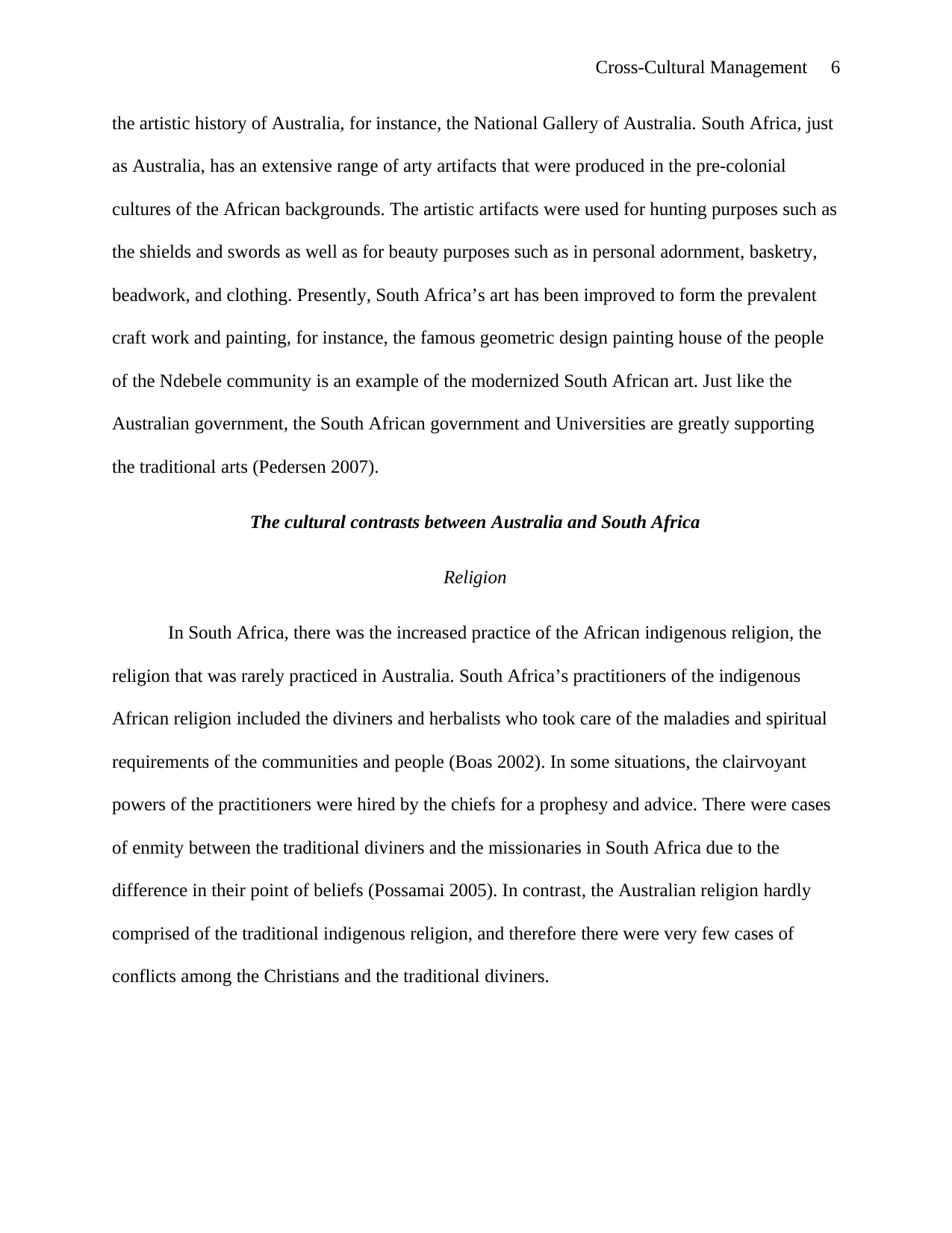
Cross-Cultural Management 6
the artistic history of Australia, for instance, the National Gallery of Australia. South Africa, just
as Australia, has an extensive range of arty artifacts that were produced in the pre-colonial
cultures of the African backgrounds. The artistic artifacts were used for hunting purposes such as
the shields and swords as well as for beauty purposes such as in personal adornment, basketry,
beadwork, and clothing. Presently, South Africa’s art has been improved to form the prevalent
craft work and painting, for instance, the famous geometric design painting house of the people
of the Ndebele community is an example of the modernized South African art. Just like the
Australian government, the South African government and Universities are greatly supporting
the traditional arts (Pedersen 2007).
The cultural contrasts between Australia and South Africa
Religion
In South Africa, there was the increased practice of the African indigenous religion, the
religion that was rarely practiced in Australia. South Africa’s practitioners of the indigenous
African religion included the diviners and herbalists who took care of the maladies and spiritual
requirements of the communities and people (Boas 2002). In some situations, the clairvoyant
powers of the practitioners were hired by the chiefs for a prophesy and advice. There were cases
of enmity between the traditional diviners and the missionaries in South Africa due to the
difference in their point of beliefs (Possamai 2005). In contrast, the Australian religion hardly
comprised of the traditional indigenous religion, and therefore there were very few cases of
conflicts among the Christians and the traditional diviners.
the artistic history of Australia, for instance, the National Gallery of Australia. South Africa, just
as Australia, has an extensive range of arty artifacts that were produced in the pre-colonial
cultures of the African backgrounds. The artistic artifacts were used for hunting purposes such as
the shields and swords as well as for beauty purposes such as in personal adornment, basketry,
beadwork, and clothing. Presently, South Africa’s art has been improved to form the prevalent
craft work and painting, for instance, the famous geometric design painting house of the people
of the Ndebele community is an example of the modernized South African art. Just like the
Australian government, the South African government and Universities are greatly supporting
the traditional arts (Pedersen 2007).
The cultural contrasts between Australia and South Africa
Religion
In South Africa, there was the increased practice of the African indigenous religion, the
religion that was rarely practiced in Australia. South Africa’s practitioners of the indigenous
African religion included the diviners and herbalists who took care of the maladies and spiritual
requirements of the communities and people (Boas 2002). In some situations, the clairvoyant
powers of the practitioners were hired by the chiefs for a prophesy and advice. There were cases
of enmity between the traditional diviners and the missionaries in South Africa due to the
difference in their point of beliefs (Possamai 2005). In contrast, the Australian religion hardly
comprised of the traditional indigenous religion, and therefore there were very few cases of
conflicts among the Christians and the traditional diviners.
⊘ This is a preview!⊘
Do you want full access?
Subscribe today to unlock all pages.

Trusted by 1+ million students worldwide
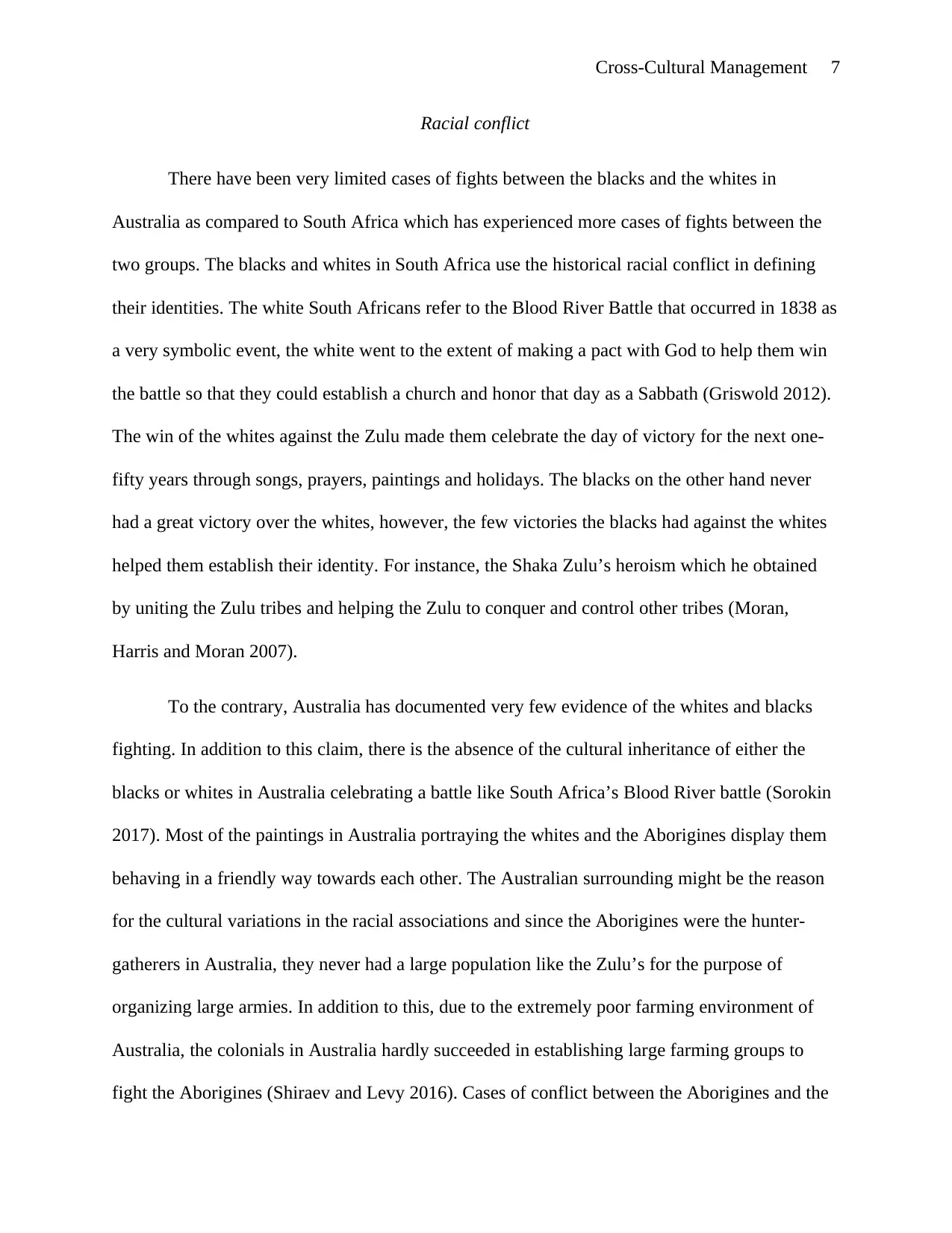
Cross-Cultural Management 7
Racial conflict
There have been very limited cases of fights between the blacks and the whites in
Australia as compared to South Africa which has experienced more cases of fights between the
two groups. The blacks and whites in South Africa use the historical racial conflict in defining
their identities. The white South Africans refer to the Blood River Battle that occurred in 1838 as
a very symbolic event, the white went to the extent of making a pact with God to help them win
the battle so that they could establish a church and honor that day as a Sabbath (Griswold 2012).
The win of the whites against the Zulu made them celebrate the day of victory for the next one-
fifty years through songs, prayers, paintings and holidays. The blacks on the other hand never
had a great victory over the whites, however, the few victories the blacks had against the whites
helped them establish their identity. For instance, the Shaka Zulu’s heroism which he obtained
by uniting the Zulu tribes and helping the Zulu to conquer and control other tribes (Moran,
Harris and Moran 2007).
To the contrary, Australia has documented very few evidence of the whites and blacks
fighting. In addition to this claim, there is the absence of the cultural inheritance of either the
blacks or whites in Australia celebrating a battle like South Africa’s Blood River battle (Sorokin
2017). Most of the paintings in Australia portraying the whites and the Aborigines display them
behaving in a friendly way towards each other. The Australian surrounding might be the reason
for the cultural variations in the racial associations and since the Aborigines were the hunter-
gatherers in Australia, they never had a large population like the Zulu’s for the purpose of
organizing large armies. In addition to this, due to the extremely poor farming environment of
Australia, the colonials in Australia hardly succeeded in establishing large farming groups to
fight the Aborigines (Shiraev and Levy 2016). Cases of conflict between the Aborigines and the
Racial conflict
There have been very limited cases of fights between the blacks and the whites in
Australia as compared to South Africa which has experienced more cases of fights between the
two groups. The blacks and whites in South Africa use the historical racial conflict in defining
their identities. The white South Africans refer to the Blood River Battle that occurred in 1838 as
a very symbolic event, the white went to the extent of making a pact with God to help them win
the battle so that they could establish a church and honor that day as a Sabbath (Griswold 2012).
The win of the whites against the Zulu made them celebrate the day of victory for the next one-
fifty years through songs, prayers, paintings and holidays. The blacks on the other hand never
had a great victory over the whites, however, the few victories the blacks had against the whites
helped them establish their identity. For instance, the Shaka Zulu’s heroism which he obtained
by uniting the Zulu tribes and helping the Zulu to conquer and control other tribes (Moran,
Harris and Moran 2007).
To the contrary, Australia has documented very few evidence of the whites and blacks
fighting. In addition to this claim, there is the absence of the cultural inheritance of either the
blacks or whites in Australia celebrating a battle like South Africa’s Blood River battle (Sorokin
2017). Most of the paintings in Australia portraying the whites and the Aborigines display them
behaving in a friendly way towards each other. The Australian surrounding might be the reason
for the cultural variations in the racial associations and since the Aborigines were the hunter-
gatherers in Australia, they never had a large population like the Zulu’s for the purpose of
organizing large armies. In addition to this, due to the extremely poor farming environment of
Australia, the colonials in Australia hardly succeeded in establishing large farming groups to
fight the Aborigines (Shiraev and Levy 2016). Cases of conflict between the Aborigines and the
Paraphrase This Document
Need a fresh take? Get an instant paraphrase of this document with our AI Paraphraser
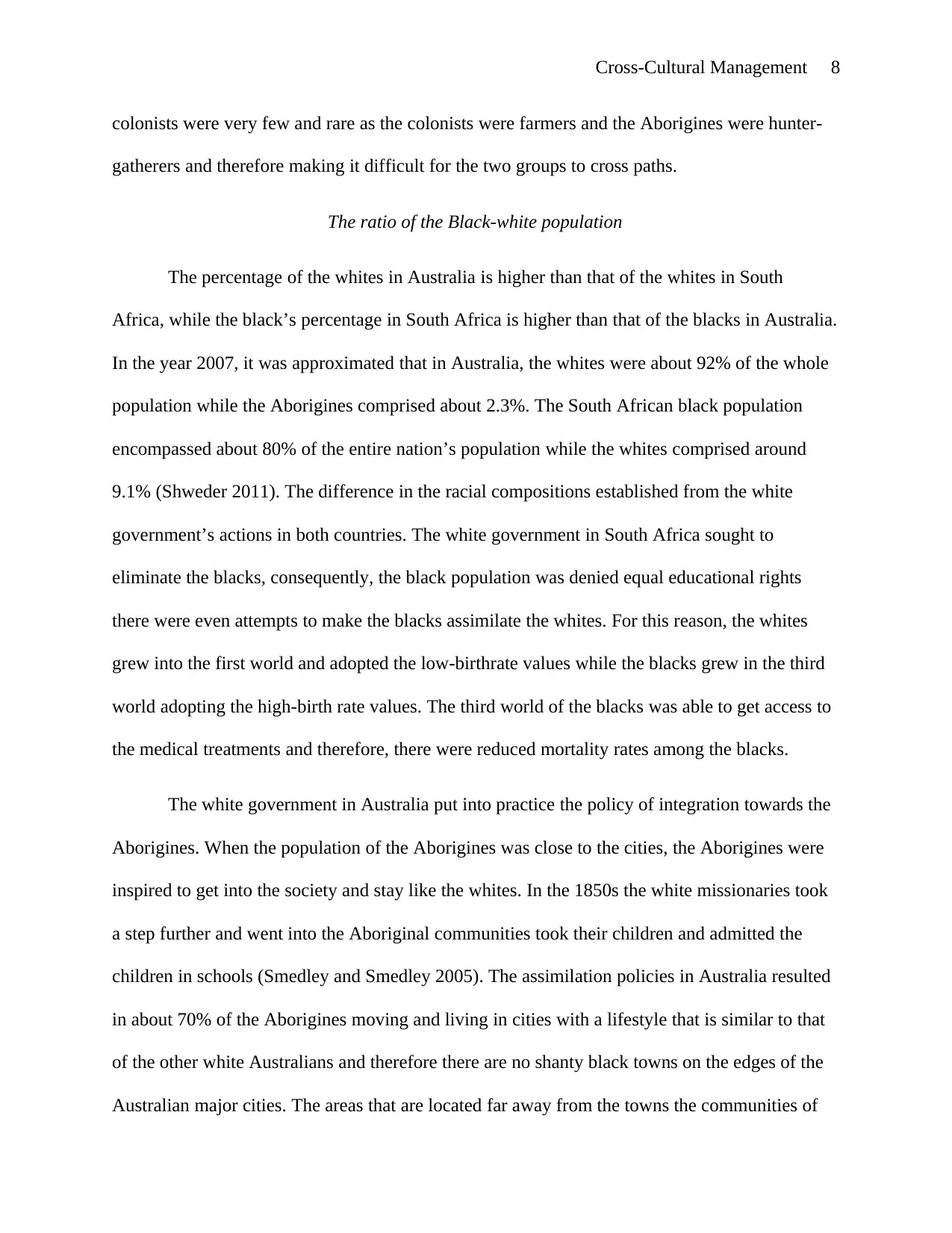
Cross-Cultural Management 8
colonists were very few and rare as the colonists were farmers and the Aborigines were hunter-
gatherers and therefore making it difficult for the two groups to cross paths.
The ratio of the Black-white population
The percentage of the whites in Australia is higher than that of the whites in South
Africa, while the black’s percentage in South Africa is higher than that of the blacks in Australia.
In the year 2007, it was approximated that in Australia, the whites were about 92% of the whole
population while the Aborigines comprised about 2.3%. The South African black population
encompassed about 80% of the entire nation’s population while the whites comprised around
9.1% (Shweder 2011). The difference in the racial compositions established from the white
government’s actions in both countries. The white government in South Africa sought to
eliminate the blacks, consequently, the black population was denied equal educational rights
there were even attempts to make the blacks assimilate the whites. For this reason, the whites
grew into the first world and adopted the low-birthrate values while the blacks grew in the third
world adopting the high-birth rate values. The third world of the blacks was able to get access to
the medical treatments and therefore, there were reduced mortality rates among the blacks.
The white government in Australia put into practice the policy of integration towards the
Aborigines. When the population of the Aborigines was close to the cities, the Aborigines were
inspired to get into the society and stay like the whites. In the 1850s the white missionaries took
a step further and went into the Aboriginal communities took their children and admitted the
children in schools (Smedley and Smedley 2005). The assimilation policies in Australia resulted
in about 70% of the Aborigines moving and living in cities with a lifestyle that is similar to that
of the other white Australians and therefore there are no shanty black towns on the edges of the
Australian major cities. The areas that are located far away from the towns the communities of
colonists were very few and rare as the colonists were farmers and the Aborigines were hunter-
gatherers and therefore making it difficult for the two groups to cross paths.
The ratio of the Black-white population
The percentage of the whites in Australia is higher than that of the whites in South
Africa, while the black’s percentage in South Africa is higher than that of the blacks in Australia.
In the year 2007, it was approximated that in Australia, the whites were about 92% of the whole
population while the Aborigines comprised about 2.3%. The South African black population
encompassed about 80% of the entire nation’s population while the whites comprised around
9.1% (Shweder 2011). The difference in the racial compositions established from the white
government’s actions in both countries. The white government in South Africa sought to
eliminate the blacks, consequently, the black population was denied equal educational rights
there were even attempts to make the blacks assimilate the whites. For this reason, the whites
grew into the first world and adopted the low-birthrate values while the blacks grew in the third
world adopting the high-birth rate values. The third world of the blacks was able to get access to
the medical treatments and therefore, there were reduced mortality rates among the blacks.
The white government in Australia put into practice the policy of integration towards the
Aborigines. When the population of the Aborigines was close to the cities, the Aborigines were
inspired to get into the society and stay like the whites. In the 1850s the white missionaries took
a step further and went into the Aboriginal communities took their children and admitted the
children in schools (Smedley and Smedley 2005). The assimilation policies in Australia resulted
in about 70% of the Aborigines moving and living in cities with a lifestyle that is similar to that
of the other white Australians and therefore there are no shanty black towns on the edges of the
Australian major cities. The areas that are located far away from the towns the communities of
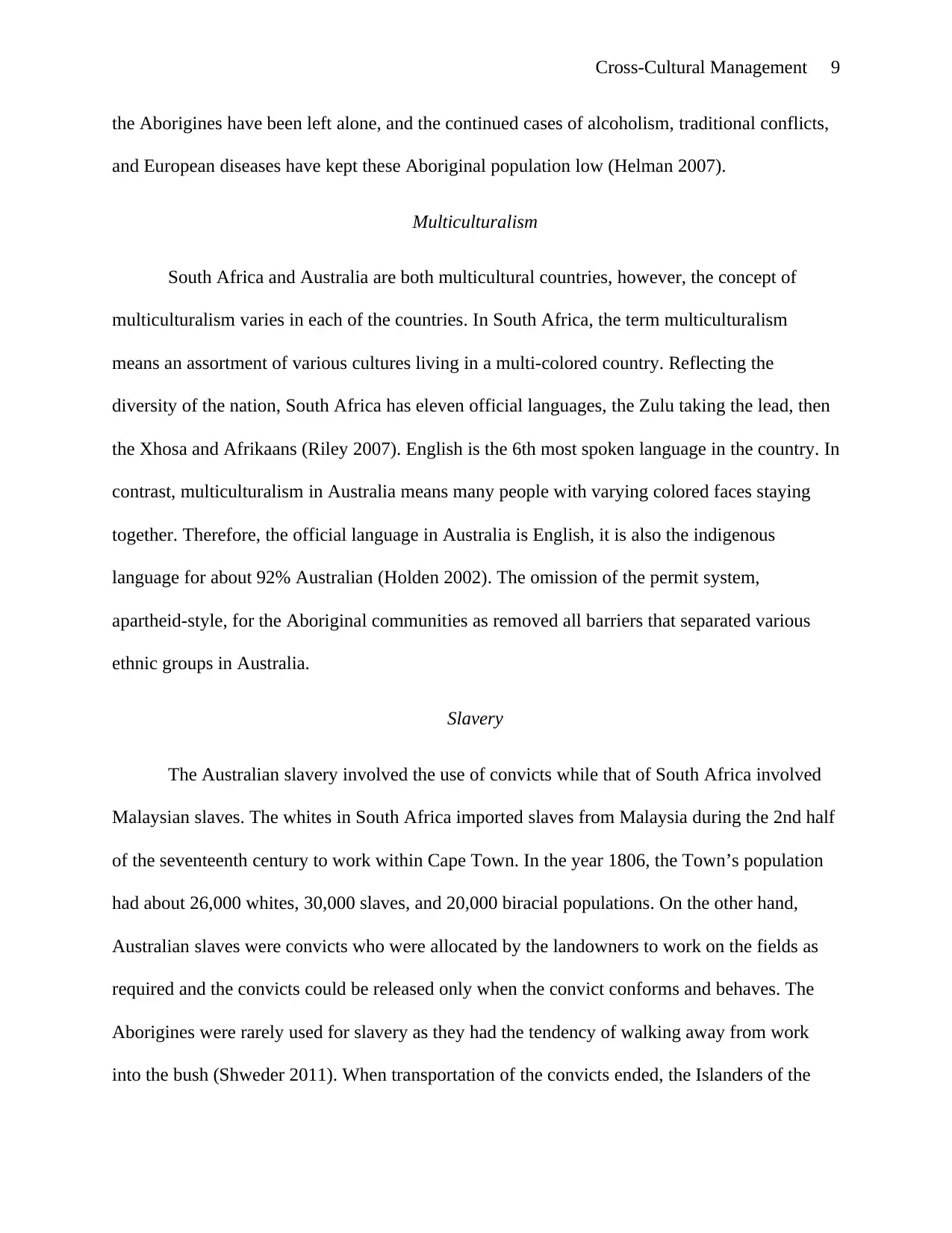
Cross-Cultural Management 9
the Aborigines have been left alone, and the continued cases of alcoholism, traditional conflicts,
and European diseases have kept these Aboriginal population low (Helman 2007).
Multiculturalism
South Africa and Australia are both multicultural countries, however, the concept of
multiculturalism varies in each of the countries. In South Africa, the term multiculturalism
means an assortment of various cultures living in a multi-colored country. Reflecting the
diversity of the nation, South Africa has eleven official languages, the Zulu taking the lead, then
the Xhosa and Afrikaans (Riley 2007). English is the 6th most spoken language in the country. In
contrast, multiculturalism in Australia means many people with varying colored faces staying
together. Therefore, the official language in Australia is English, it is also the indigenous
language for about 92% Australian (Holden 2002). The omission of the permit system,
apartheid-style, for the Aboriginal communities as removed all barriers that separated various
ethnic groups in Australia.
Slavery
The Australian slavery involved the use of convicts while that of South Africa involved
Malaysian slaves. The whites in South Africa imported slaves from Malaysia during the 2nd half
of the seventeenth century to work within Cape Town. In the year 1806, the Town’s population
had about 26,000 whites, 30,000 slaves, and 20,000 biracial populations. On the other hand,
Australian slaves were convicts who were allocated by the landowners to work on the fields as
required and the convicts could be released only when the convict conforms and behaves. The
Aborigines were rarely used for slavery as they had the tendency of walking away from work
into the bush (Shweder 2011). When transportation of the convicts ended, the Islanders of the
the Aborigines have been left alone, and the continued cases of alcoholism, traditional conflicts,
and European diseases have kept these Aboriginal population low (Helman 2007).
Multiculturalism
South Africa and Australia are both multicultural countries, however, the concept of
multiculturalism varies in each of the countries. In South Africa, the term multiculturalism
means an assortment of various cultures living in a multi-colored country. Reflecting the
diversity of the nation, South Africa has eleven official languages, the Zulu taking the lead, then
the Xhosa and Afrikaans (Riley 2007). English is the 6th most spoken language in the country. In
contrast, multiculturalism in Australia means many people with varying colored faces staying
together. Therefore, the official language in Australia is English, it is also the indigenous
language for about 92% Australian (Holden 2002). The omission of the permit system,
apartheid-style, for the Aboriginal communities as removed all barriers that separated various
ethnic groups in Australia.
Slavery
The Australian slavery involved the use of convicts while that of South Africa involved
Malaysian slaves. The whites in South Africa imported slaves from Malaysia during the 2nd half
of the seventeenth century to work within Cape Town. In the year 1806, the Town’s population
had about 26,000 whites, 30,000 slaves, and 20,000 biracial populations. On the other hand,
Australian slaves were convicts who were allocated by the landowners to work on the fields as
required and the convicts could be released only when the convict conforms and behaves. The
Aborigines were rarely used for slavery as they had the tendency of walking away from work
into the bush (Shweder 2011). When transportation of the convicts ended, the Islanders of the
⊘ This is a preview!⊘
Do you want full access?
Subscribe today to unlock all pages.

Trusted by 1+ million students worldwide
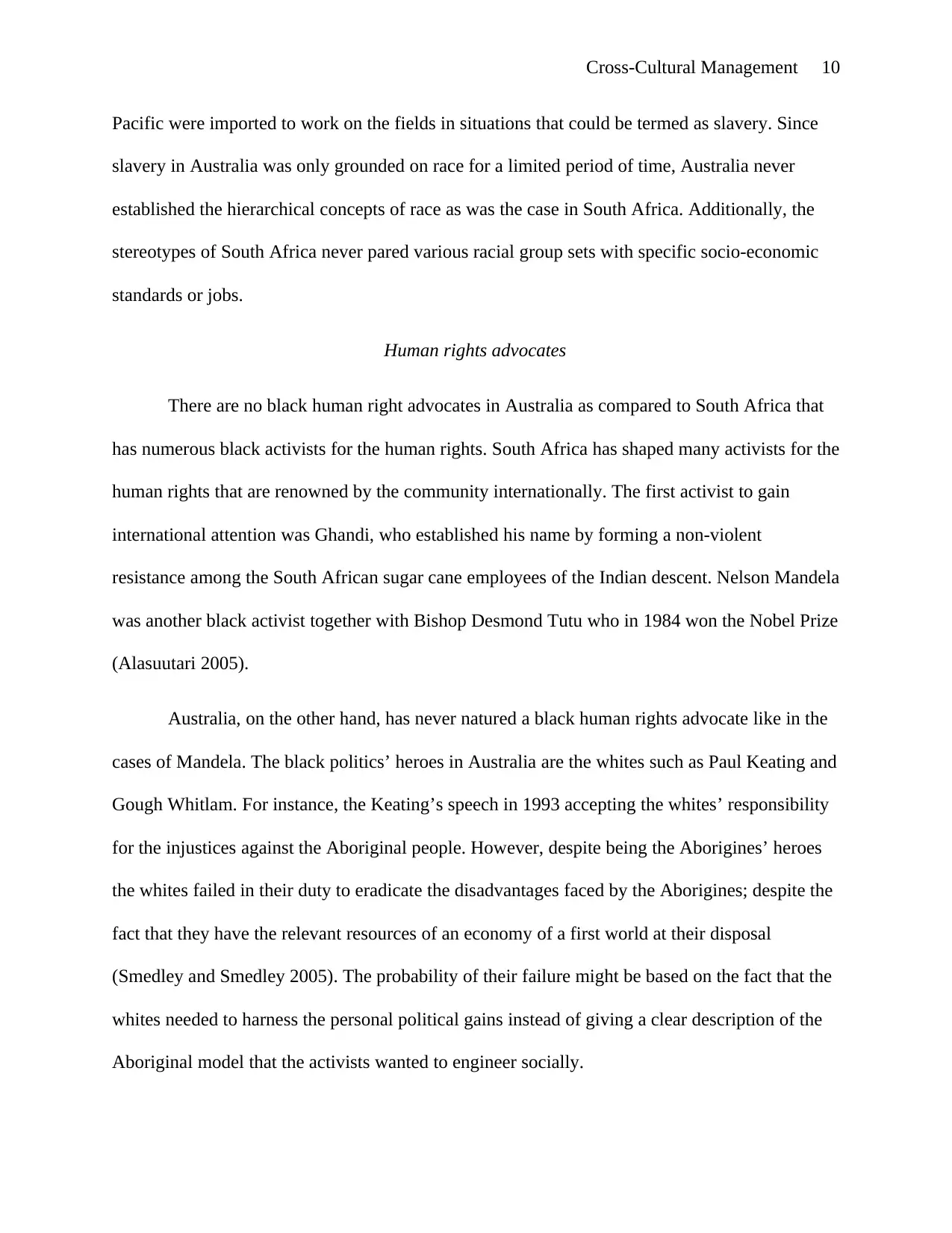
Cross-Cultural Management 10
Pacific were imported to work on the fields in situations that could be termed as slavery. Since
slavery in Australia was only grounded on race for a limited period of time, Australia never
established the hierarchical concepts of race as was the case in South Africa. Additionally, the
stereotypes of South Africa never pared various racial group sets with specific socio-economic
standards or jobs.
Human rights advocates
There are no black human right advocates in Australia as compared to South Africa that
has numerous black activists for the human rights. South Africa has shaped many activists for the
human rights that are renowned by the community internationally. The first activist to gain
international attention was Ghandi, who established his name by forming a non-violent
resistance among the South African sugar cane employees of the Indian descent. Nelson Mandela
was another black activist together with Bishop Desmond Tutu who in 1984 won the Nobel Prize
(Alasuutari 2005).
Australia, on the other hand, has never natured a black human rights advocate like in the
cases of Mandela. The black politics’ heroes in Australia are the whites such as Paul Keating and
Gough Whitlam. For instance, the Keating’s speech in 1993 accepting the whites’ responsibility
for the injustices against the Aboriginal people. However, despite being the Aborigines’ heroes
the whites failed in their duty to eradicate the disadvantages faced by the Aborigines; despite the
fact that they have the relevant resources of an economy of a first world at their disposal
(Smedley and Smedley 2005). The probability of their failure might be based on the fact that the
whites needed to harness the personal political gains instead of giving a clear description of the
Aboriginal model that the activists wanted to engineer socially.
Pacific were imported to work on the fields in situations that could be termed as slavery. Since
slavery in Australia was only grounded on race for a limited period of time, Australia never
established the hierarchical concepts of race as was the case in South Africa. Additionally, the
stereotypes of South Africa never pared various racial group sets with specific socio-economic
standards or jobs.
Human rights advocates
There are no black human right advocates in Australia as compared to South Africa that
has numerous black activists for the human rights. South Africa has shaped many activists for the
human rights that are renowned by the community internationally. The first activist to gain
international attention was Ghandi, who established his name by forming a non-violent
resistance among the South African sugar cane employees of the Indian descent. Nelson Mandela
was another black activist together with Bishop Desmond Tutu who in 1984 won the Nobel Prize
(Alasuutari 2005).
Australia, on the other hand, has never natured a black human rights advocate like in the
cases of Mandela. The black politics’ heroes in Australia are the whites such as Paul Keating and
Gough Whitlam. For instance, the Keating’s speech in 1993 accepting the whites’ responsibility
for the injustices against the Aboriginal people. However, despite being the Aborigines’ heroes
the whites failed in their duty to eradicate the disadvantages faced by the Aborigines; despite the
fact that they have the relevant resources of an economy of a first world at their disposal
(Smedley and Smedley 2005). The probability of their failure might be based on the fact that the
whites needed to harness the personal political gains instead of giving a clear description of the
Aboriginal model that the activists wanted to engineer socially.
Paraphrase This Document
Need a fresh take? Get an instant paraphrase of this document with our AI Paraphraser
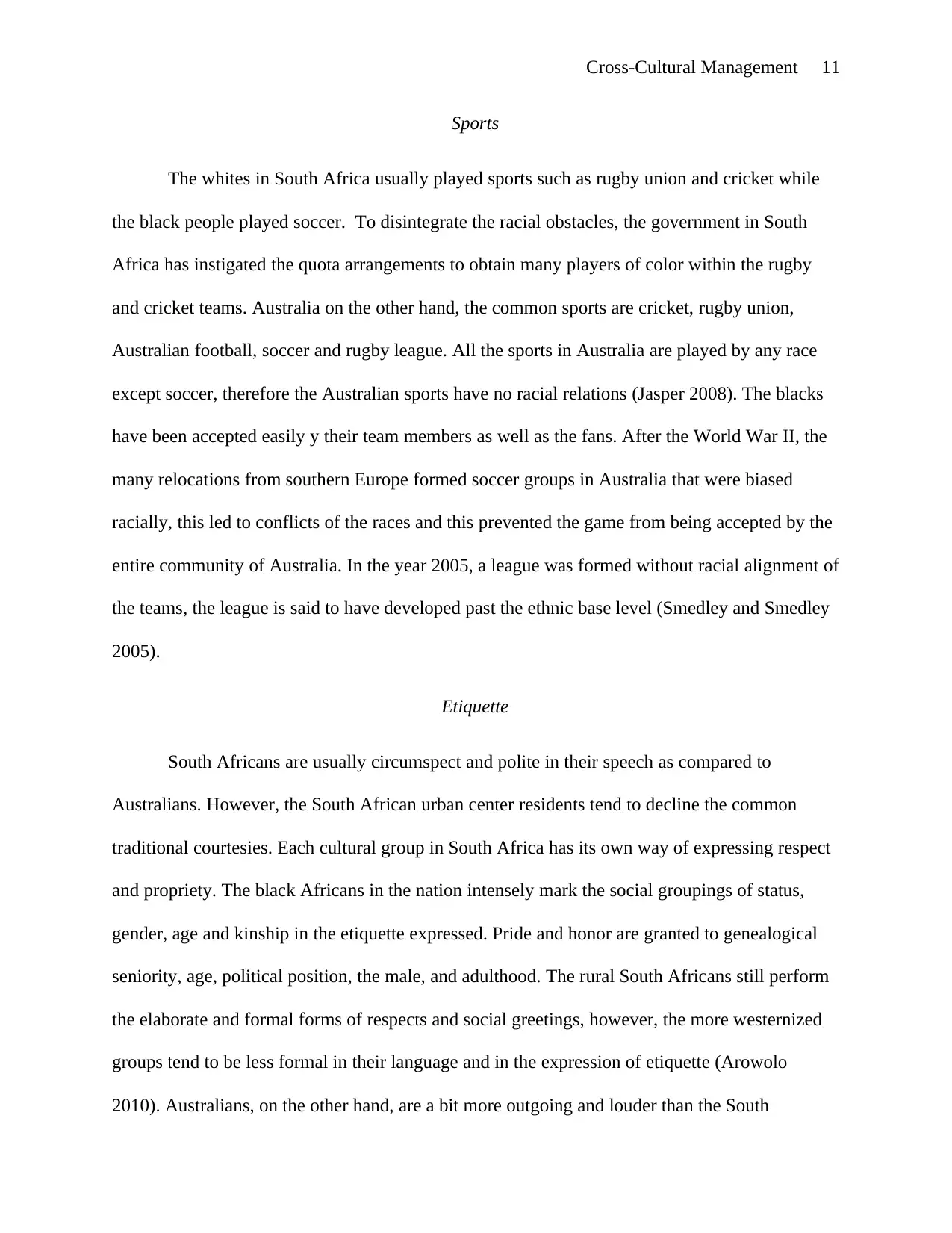
Cross-Cultural Management 11
Sports
The whites in South Africa usually played sports such as rugby union and cricket while
the black people played soccer. To disintegrate the racial obstacles, the government in South
Africa has instigated the quota arrangements to obtain many players of color within the rugby
and cricket teams. Australia on the other hand, the common sports are cricket, rugby union,
Australian football, soccer and rugby league. All the sports in Australia are played by any race
except soccer, therefore the Australian sports have no racial relations (Jasper 2008). The blacks
have been accepted easily y their team members as well as the fans. After the World War II, the
many relocations from southern Europe formed soccer groups in Australia that were biased
racially, this led to conflicts of the races and this prevented the game from being accepted by the
entire community of Australia. In the year 2005, a league was formed without racial alignment of
the teams, the league is said to have developed past the ethnic base level (Smedley and Smedley
2005).
Etiquette
South Africans are usually circumspect and polite in their speech as compared to
Australians. However, the South African urban center residents tend to decline the common
traditional courtesies. Each cultural group in South Africa has its own way of expressing respect
and propriety. The black Africans in the nation intensely mark the social groupings of status,
gender, age and kinship in the etiquette expressed. Pride and honor are granted to genealogical
seniority, age, political position, the male, and adulthood. The rural South Africans still perform
the elaborate and formal forms of respects and social greetings, however, the more westernized
groups tend to be less formal in their language and in the expression of etiquette (Arowolo
2010). Australians, on the other hand, are a bit more outgoing and louder than the South
Sports
The whites in South Africa usually played sports such as rugby union and cricket while
the black people played soccer. To disintegrate the racial obstacles, the government in South
Africa has instigated the quota arrangements to obtain many players of color within the rugby
and cricket teams. Australia on the other hand, the common sports are cricket, rugby union,
Australian football, soccer and rugby league. All the sports in Australia are played by any race
except soccer, therefore the Australian sports have no racial relations (Jasper 2008). The blacks
have been accepted easily y their team members as well as the fans. After the World War II, the
many relocations from southern Europe formed soccer groups in Australia that were biased
racially, this led to conflicts of the races and this prevented the game from being accepted by the
entire community of Australia. In the year 2005, a league was formed without racial alignment of
the teams, the league is said to have developed past the ethnic base level (Smedley and Smedley
2005).
Etiquette
South Africans are usually circumspect and polite in their speech as compared to
Australians. However, the South African urban center residents tend to decline the common
traditional courtesies. Each cultural group in South Africa has its own way of expressing respect
and propriety. The black Africans in the nation intensely mark the social groupings of status,
gender, age and kinship in the etiquette expressed. Pride and honor are granted to genealogical
seniority, age, political position, the male, and adulthood. The rural South Africans still perform
the elaborate and formal forms of respects and social greetings, however, the more westernized
groups tend to be less formal in their language and in the expression of etiquette (Arowolo
2010). Australians, on the other hand, are a bit more outgoing and louder than the South
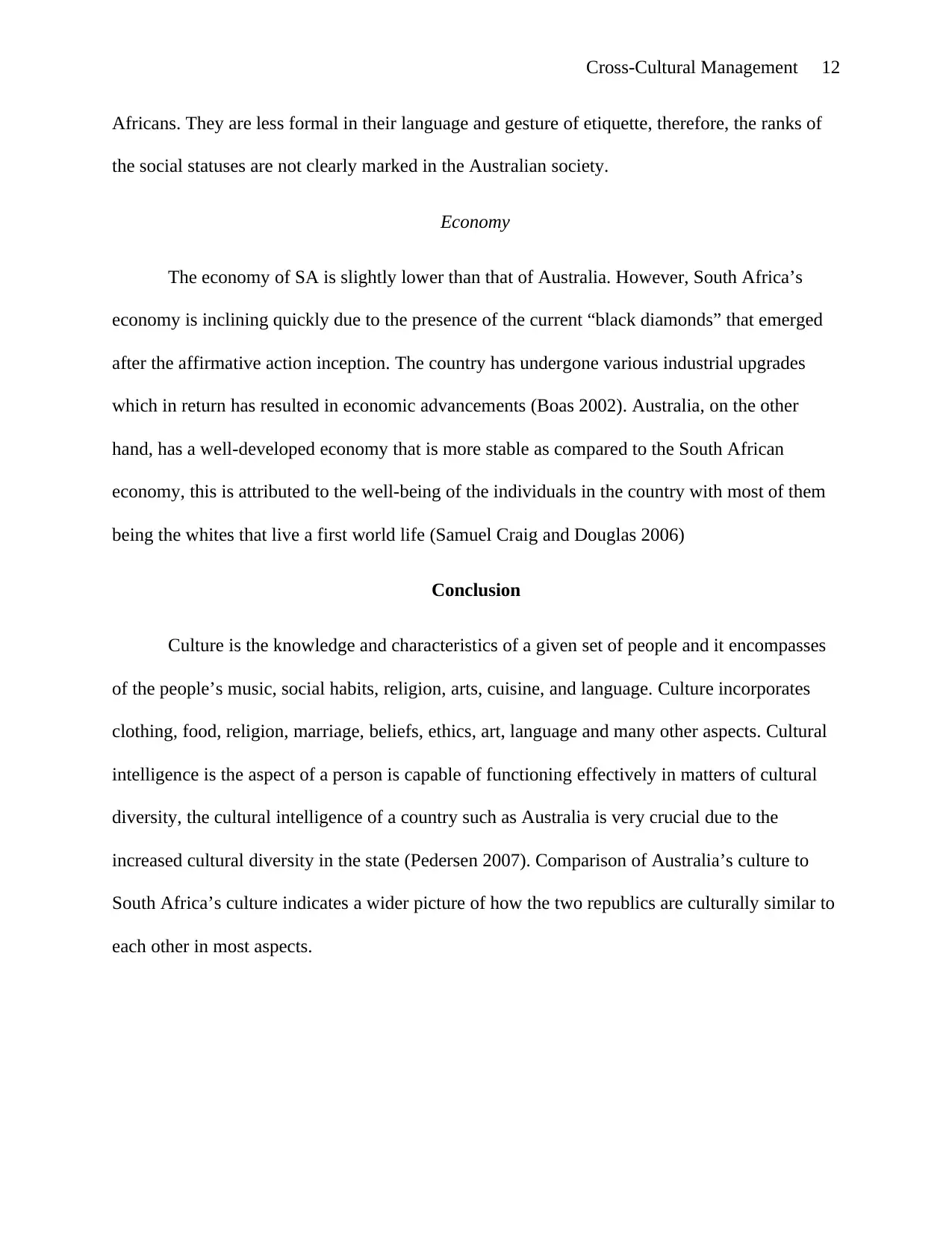
Cross-Cultural Management 12
Africans. They are less formal in their language and gesture of etiquette, therefore, the ranks of
the social statuses are not clearly marked in the Australian society.
Economy
The economy of SA is slightly lower than that of Australia. However, South Africa’s
economy is inclining quickly due to the presence of the current “black diamonds” that emerged
after the affirmative action inception. The country has undergone various industrial upgrades
which in return has resulted in economic advancements (Boas 2002). Australia, on the other
hand, has a well-developed economy that is more stable as compared to the South African
economy, this is attributed to the well-being of the individuals in the country with most of them
being the whites that live a first world life (Samuel Craig and Douglas 2006)
Conclusion
Culture is the knowledge and characteristics of a given set of people and it encompasses
of the people’s music, social habits, religion, arts, cuisine, and language. Culture incorporates
clothing, food, religion, marriage, beliefs, ethics, art, language and many other aspects. Cultural
intelligence is the aspect of a person is capable of functioning effectively in matters of cultural
diversity, the cultural intelligence of a country such as Australia is very crucial due to the
increased cultural diversity in the state (Pedersen 2007). Comparison of Australia’s culture to
South Africa’s culture indicates a wider picture of how the two republics are culturally similar to
each other in most aspects.
Africans. They are less formal in their language and gesture of etiquette, therefore, the ranks of
the social statuses are not clearly marked in the Australian society.
Economy
The economy of SA is slightly lower than that of Australia. However, South Africa’s
economy is inclining quickly due to the presence of the current “black diamonds” that emerged
after the affirmative action inception. The country has undergone various industrial upgrades
which in return has resulted in economic advancements (Boas 2002). Australia, on the other
hand, has a well-developed economy that is more stable as compared to the South African
economy, this is attributed to the well-being of the individuals in the country with most of them
being the whites that live a first world life (Samuel Craig and Douglas 2006)
Conclusion
Culture is the knowledge and characteristics of a given set of people and it encompasses
of the people’s music, social habits, religion, arts, cuisine, and language. Culture incorporates
clothing, food, religion, marriage, beliefs, ethics, art, language and many other aspects. Cultural
intelligence is the aspect of a person is capable of functioning effectively in matters of cultural
diversity, the cultural intelligence of a country such as Australia is very crucial due to the
increased cultural diversity in the state (Pedersen 2007). Comparison of Australia’s culture to
South Africa’s culture indicates a wider picture of how the two republics are culturally similar to
each other in most aspects.
⊘ This is a preview!⊘
Do you want full access?
Subscribe today to unlock all pages.

Trusted by 1+ million students worldwide
1 out of 15
Related Documents
Your All-in-One AI-Powered Toolkit for Academic Success.
+13062052269
info@desklib.com
Available 24*7 on WhatsApp / Email
![[object Object]](/_next/static/media/star-bottom.7253800d.svg)
Unlock your academic potential
Copyright © 2020–2025 A2Z Services. All Rights Reserved. Developed and managed by ZUCOL.




